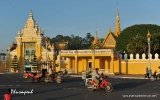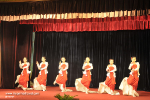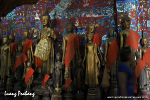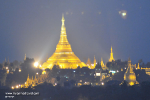The King was a great builder and donator of pagodas and monasteries. He spent much of his time on water journeys both inland and abroad. Legend said that the royal barge which the King used, was built of the wood that contained a philosopher’s stone. So, the Barge had supernatural power of turning into water any place the king pointed at. So once, during one of his journeys, he came to the Inle Lake and the royal barge stopped at a place. That place was marked as a sacred place and a pagoda was built.
The center shrine in the main hall of Phaung Daw Oo Pagoda houses five small golden Buddha images. The Buddha images have been covered with so many gold leaves that it is impossible to see their original structure. The gold-leaf application to such excess is relatively recent. Although the monastery is open to all for veneration, only men are permitted to place gold leaf on the images. Another part of the ritual for pilgrims is to place a small robe or thingan around the images, and to take the robe back to their houses and place it on their own altar as a token of respect for the Buddha and his teachings. The images are of differing sizes, range from about nine to eighteen inches tall. Being essentially solid gold, the images are extremely heavy.
Annually, during the Burmese month of Thadingyut (from September to October), an 18-day pagoda festival is held. On festival, four of the Buddha images are placed on a replica of a royal barge designed as a hintha bird and taken throughout Inlay Lake. One image always remains at the temple. The elaborately decorated barge is towed by several boats of leg-rowers rowing in unison, and other accompanying boats, making an impressive procession on the water. The barge is towed from village to village along the shores of the lake in clockwise fashion, and the four images reside at the main monastery in each village for the night. The high point of the festival is on the day when the images arrive at the main town of Nyaungshwe, where most pilgrims from the surrounding region come to pay their respects and veneration.
Note:
Address: Ywama village, Inle lake, Shan state, Myanmar
Location: Located at the southern from Ywama to Tha Ley village. Only way to come the pagoda is by boat
Open daily – daylight time
Fee: Camera/video fee: 200 – 300 Ks
The festival is celebrated around September – October annually, last 18 days
Highlights:
Boat through a wide channel leads south from Ywama to the village of Tha Ley, you will reach to Phaung Daw Oo pagoda. Surrounding the Pagoda, and in the basement are shops selling traditional Shan and Burmese merchandise. Inside the huge tiered pagoda is the place to enshrine 5 ancient Buddha images which are solid gold. The Buddha images have been covered with so many gold leaves day by day. Also the royal barge nearby which is use once a year on festival to carry the Buddha images, is worth a look.
It is a fascinating spectacle if you go here at a right time around September – October, you can enjoy the Phaung Daw Oo festival. During the festival, the images are paraded around the lake in an ornate barge shaped like a Hintha. Local families often bring their children here as part of the ordination rites for the sangha (Buddhist brotherhood)
{mainvote}






